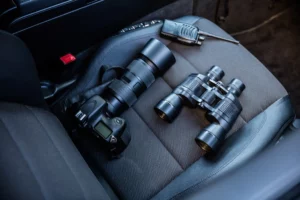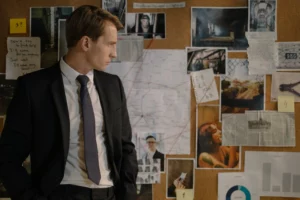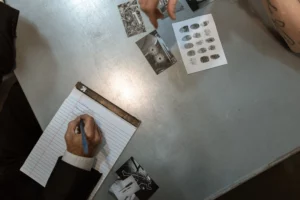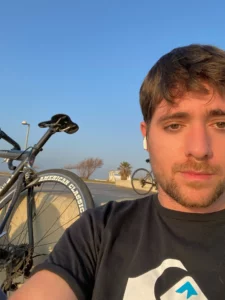Stepping into the world of private investigators (PI) is akin to stepping into the shadows. It’s an arena of the unseen, the discreet, and the quietly significant. Of all the duties a private investigator undertakes, perhaps none is more intriguing, or more crucial, than surveillance. This covert practice is a cornerstone of the investigative process, revealing truths that remain hidden from the untrained eye. In this article, we aim to shed light on the clandestine world of surveillance.
Now, imagine this: You’re a PI. It’s a cool evening, and you’re in your car, parked just out of sight. Ahead of you is the subject of your investigation, oblivious to your presence. With a blend of stealth, technology, and patience, you’re about to gather evidence that may turn the tide of a legal case, or reveal the truth about a potential infidelity. This is your world.

This might sound like a plotline lifted straight from a detective novel, but it’s an all-too-real part of a PIs job. And it’s not all dramatic car chases and high-tech gadgetry; this job requires ethics, integrity, and a solid understanding of the law.
Surveillance plays a key role in gathering the pieces of the puzzle, from documenting personal habits to tracking illicit activities. Whether it’s for personal or professional purposes, it is often the linchpin that determines the success of an investigation.
In the following sections, we’ll be exploring the role it plays, the tools used, the ethical implications, and some of the challenges faced.
The role of surveillance
Let’s delve into the specifics of why surveillance plays such a pivotal role.
Assembling the Pieces
Imagine trying to complete a puzzle, but the pieces aren’t all in the box; they’re scattered, hidden, obscured. This is the landscape a private investigator navigates. Each hidden piece represents a detail that can complete the picture of a person’s activities or habits. Surveillance is the tool they use to locate these elusive pieces.
Through observation, they gather essential information, such as a subject’s daily routines or clandestine meetings. Even seemingly mundane details can be crucial in building a complete and accurate picture of the situation at hand.
Documenting Evidence
One of the significant roles of surveillance is to document evidence. This process involves recording actions, interactions, and movements, which in turn become the hard proof necessary for a case.
This documentation can include:
- Routine activities: While they might seem unimportant, these can often highlight anomalies or patterns that are crucial to the investigation.
- Interactions with others: These provide valuable context or even identify new subjects of interest.
- Locations visited: If the subject visits an unexpected location, this could indicate hidden aspects of their life.
Ensuring Objectivity
Surveillance also helps ensure objectivity in an investigation. While some parts might be influenced by personal judgment or interpretation, surveillance offers a real-time, unfiltered view of the subject’s actions. What a PI observes during surveillance is the truth of what occurred, not a retelling or interpretation.
Impacting Outcomes
Perhaps most importantly, surveillance can directly affect the outcome of a case. Whether it’s a personal matter like a suspected infidelity or a legal issue such as insurance fraud, the evidence obtained can be the deciding factor.
For example, in a child custody case, a PI might be tasked with observing a parent’s behavior. Surveillance could uncover activities that question the subject’s fitness as a parent, influencing the court’s decision.
As you dive deeper into the world of PI surveillance, remember that the game-changer could be the subtle, often overlooked detail, not just the big revelations.
Tools of the Trade

Have you ever wondered what gadgets and gear a private investigator employs during surveillance? From the traditional to the cutting-edge, the tools at their disposal are numerous and varied. They use these to discreetly gather information while keeping a low profile.
Cameras and optics
Cameras are crucial in a PI’s toolkit. They’re used for taking photographs and recording videos that can serve as concrete evidence in an investigation. But not just any camera will do. The types of cameras used include:
- Digital SLR cameras: These are used for their superior image quality and the ability to use a variety of lenses, including telephoto lenses for long-distance shots.
- Covert cameras: These are hidden in everyday objects like pens, keychains, or even buttonholes, allowing them to capture images without drawing attention.
- Night vision cameras: When the sun goes down, these cameras use infrared technology to see in the dark.
- Drones: These unmanned aerial vehicles can capture footage from an elevated perspective, providing a bird’s-eye view of a location.
Audio Equipment
Listening devices, or bugs, are used to record conversations when it’s legal and ethical to do so. These can be as small as a button and are often hidden in plain sight. In some cases, a directional microphone might be used. This allows the investigator to pick up on conversations from a distance.
Tracking Devices
GPS trackers are often used. These can be discretely placed on a vehicle to track its movements, allowing the investigator to maintain surveillance without needing to be physically present at all times.
Surveillance Vans
You’ve probably seen them in movies- unassuming vans parked inconspicuously on a street. These vehicles are often equipped with a variety of surveillance tools, like monitors connected to cameras or GPS trackers, and tinted windows or viewing slots for direct observation.
Computer Software
In the digital age, surveillance extends beyond physical observation. Private investigators often use various software tools for online investigations. This can include social media monitoring tools, data recovery software, and even specialized search engines to find information about a person online.
While they can enhance a private investigator’s abilities, they are just tha- tools. It’s the investigator’s skill, experience, and intuition that really drive an investigation forward. The gadgets are just there to help them work more efficiently.
The Morals

With powerful tools and techniques at their disposal, PIs tread a delicate ethical and legal line in their work. Next, we’ll examine some of the moral considerations and guidelines they adhere to when conducting surveillance.
Respecting Privacy
Just as a surgeon needs to balance their actions between life-saving intervention and respecting the human body, so too must a private investigator balance between uncovering the truth and respecting an individual’s right to privacy. Privacy laws vary by location, but a good PI knows to avoid crossing this line. For instance, filming in public places is usually legal, but capturing images inside a private residence without consent, generally isn’t.
Legality of Surveillance Tools
While a PI’s toolkit is packed with fascinating devices, their use is governed by law. Unauthorized use of listening devices, for instance, is generally illegal and can lead to severe penalties. Similarly, while GPS trackers can be used, the law surrounding their use can be complex, often requiring legal guidance to navigate.
Integrity of Information
The information gathered has the potential to significantly affect lives and court cases. Therefore, it’s of utmost importance that the investigator acts with integrity and honesty. Falsifying evidence, misrepresenting information, or omitting important details can be tempting shortcuts, but they’re not only unethical, they’re often illegal.
Confidentiality
An investigator’s duty to their client includes a commitment to confidentiality. Any personal or sensitive information uncovered during surveillance should be kept strictly confidential, shared only with the client or with others in accordance with law and the terms of the PI’s contract.
To highlight the complexity of these, consider the case of a fictitious PI, we’ll call him Max. Max was hired to gather evidence of a potentially unfaithful spouse. Using his professional skills, Max was able to uncover clear evidence of the spouse’s infidelity. However, he also stumbled upon unrelated information suggesting the spouse was involved in illegal activities.
In this scenario, Max has several ethical considerations to weigh. How should he handle the additional, potentially incriminating information? Is it within his right, or even his duty, to report this to the authorities? These are the kinds of ethical dilemmas that private investigators may face in the field.
It isn’t a matter of merely following laws. They’re about respecting privacy, maintaining integrity, ensuring the legality of methods, and upholding the confidentiality of the gathered information.
Case Study

After discussing the tools and ethics involved, it’s time to take a peek into a real-life instance. Please note that names and certain details have been altered to protect confidentiality.
The insurance fraud investigation
Let’s delve into the case of Jack Sullivan, a middle-aged office worker who filed a worker’s compensation claim. He claimed severe back injury due to an accident at his workplace, rendering him incapable of performing any physical activity. However, his employer’s insurance company had some doubts about the veracity of his claims. To validate these suspicions, they hired a private investigator, let’s call her Lara.
The surveillance begins
Once assigned to the case, Lara started her surveillance. She initially focused on monitoring Jack’s daily routine. Lara equipped her unobtrusive surveillance van with a high-definition, long-range camera, allowing her to discreetly observe Jack’s activities from a distance.
For the first few days, Lara didn’t observe anything that contradicted Jack’s claim. However, her persistence paid off on the fourth day when she spotted Jack loading heavy grocery bags into his car, seemingly without any discomfort. This act was contradictory to the limitations mentioned in his compensation claim.
Gathering Evidence
Over the next few days, Lara continued to document Jack’s physical activities. On multiple occasions, she caught him lifting heavy objects, playing with his children in the yard, and even performing yard work, all tasks that should have been impossible given his alleged back injury.
During this period, Lara made extensive use of her digital SLR camera, capturing high-resolution images that clearly showed Jack engaging in these activities. She also used a drone on a few occasions to capture aerial footage of Jack working in his yard, providing an additional perspective and further supporting evidence.
The Outcome
Armed with concrete evidence gathered through surveillance, Lara presented her findings to the insurance company. The company, in turn, used this evidence to dispute Jack’s compensation claim.
When confronted with the evidence, Jack had no choice but to withdraw his claim, acknowledging that he had exaggerated the severity of his injury. This case saved the insurance company a significant amount of money that would have been unjustly paid out.
The Challenges

As you’ve seen so far, surveillance is not as glamorous or straightforward as movies and TV shows may depict. It also comes with its own set of challenges that investigators have to manage on a daily basis:
Lengthy and unpredictable hours
Surveillance work is not a typical nine-to-five job. Private investigators often have to adjust their schedules according to the person or situation they are monitoring. This could mean working very early in the morning, very late at night, or even around the clock. Additionally, it may require extensive periods of inactivity, waiting for something significant to occur.
Maintaining Discretion
The success of a surveillance operation often relies on the PI remaining unnoticed. If the person being surveilled becomes aware of their presence, they might change their behavior or take steps to avoid detection, thus rendering the surveillance ineffective. Remaining undetected over extended periods can be a challenging task, especially in close-knit communities or in situations where the investigator has to maintain surveillance over multiple days.
Emotional Toll
While often overlooked, the emotional aspect can pose a significant challenge. Investigators may witness activities that are distressing or morally questionable. This, coupled with the isolation often experienced during long surveillance operations, can result in emotional stress.
Consider, for instance, our previously mentioned investigator, Lara. During her work, she often spends long hours alone, waiting for something to happen. The isolation, combined with the pressure of her assignment, could weigh on her emotionally over time.
Physical Risk
Although not a daily occurrence, PIs can sometimes find themselves in situations involving physical risk. This could range from the dangers of prolonged driving or sedentary observation to more direct threats from those who might not appreciate their attention.
Final Thoughts
By now, you’ve had an in-depth look into the world of PI surveillance. It’s a profession shrouded in intrigue, requiring a unique skillset, a firm grasp of legal and ethical guidelines, and a passion for uncovering the truth.
Surveillance is far more than what you see in Hollywood portrayals. It’s not just about shadowing individuals or snapping incriminating photos. As we’ve seen, surveillance is a vital tool in a private investigator’s arsenal, assisting in everything from insurance fraud investigations to solving criminal cases.
Over the course of our exploration, we’ve:
- Delved into the role surveillance plays in private investigations, highlighting how it aids in gathering crucial information that helps in resolving cases.
- Explored some of the tools used by private investigators, including long-range cameras, GPS trackers, and even drones, demonstrating that technology plays a significant role in modern PI work.
- Discussed the ethical considerations in PI surveillance, reminding us that even in the pursuit of truth, it’s essential to respect individual privacy and act with integrity.
- Dived into a case study that illuminated how PI surveillance is conducted in real-life situations, and how it can lead to successful outcomes.
- Unveiled the challenges that come with PI surveillance, from maintaining discretion and working long hours to managing emotional stress and physical risks.
It’s a world that requires patience, diligence, keen observation skills, and above all, an unwavering adherence to ethical and legal principles.

